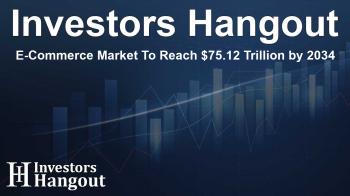E-Commerce Market To Reach $75.12 Trillion by 2034

Understanding the E-Commerce Market Growth
The global e-commerce market is witnessing remarkable expansion, with a valuation of approximately $18.77 trillion, projected to reach an astonishing $75.12 trillion within the foreseeable future. This compelling growth is attributed to an array of influencing factors, such as advancements in artificial intelligence (AI) that enhance personalization, an increase in mobile device usage, and the advance of digital payment methods.
Why is E-Commerce Thriving?
Emerging economies play an instrumental role in this growth narrative, especially in regions like Asia-Pacific, where increased internet penetration and smartphone adoption create a conducive environment for online shopping. Additionally, the integration of social media into e-commerce platforms is smothering the lines between commerce and social interaction, providing endless avenues for consumer engagement.
The Role of Technological Innovations
The world is observing a fascinating transformation in the e-commerce landscape, driven by technological innovation. Features such as augmented reality (AR), virtual reality (VR), and blockchain technology are reshaping the shopping experience to bolster consumer trust and enhance accessibility. Virtual trials and AR-enabled visualization tools allow customers to appreciate products before they buy, significantly reducing return rates and enhancing customer satisfaction.
The Power of Social Media
Platforms like Instagram, TikTok, and Facebook have revolutionized how consumers interact with brands. By utilizing targeted advertising, these platforms are enhancing e-commerce growth. Brands now have direct access to consumer behaviors and preferences, which leads to tailored marketing strategies resulting in higher conversion rates.
Market Dynamics and Future Projections
The e-commerce sector is set to evolve with powerful growth, with a forecasted CAGR of 14.88% from 2025 to 2034. The increasing preference for online shopping is coupled with enhanced digital payment solutions, enabling hassle-free transactions. Industry leaders are attributing this explosion to direct-to-consumer models that offer significant cost advantages and greater satisfaction as a result of faster shipping and personalized services.
Identifying Key Market Segments
The dominance of the business-to-business (B2B) segment, which accounted for more than 65% of total revenue in 2024, underscores the importance of inter-business transactions in the e-commerce framework. This trend is driven by the high demand for transparency regarding fulfillment, pricing, and product information.
The Significance of the Asia-Pacific Region
No discussion of e-commerce would be complete without mentioning the Asia-Pacific region, which is leading the market with over 57% of global sales in 2024. This growth can be linked to a rapidly urbanizing population, improvements in telecommunications, and a robust logistics framework that supports the transition to digital shopping.
Challenges Facing the E-Commerce Sector
Despite its rapid growth, the e-commerce market is met with various challenges, including privacy concerns and data security issues that could stymie consumer trust. The necessity for businesses to maintain transparent data collection practices is paramount as consumer awareness regarding privacy escalates.
Key Trends Impacting E-Commerce
The landscape is continuously evolving with groundbreaking trends such as the incorporation of AI in enhancing personalization, optimizing logistics, and improving fraud detection. Companies that can harness the power of these technologies will be at the forefront of e-commercial evolution.
Looking Forward: What’s Next?
Consumer expectations from e-commerce platforms will only increase in complexity and demand for seamless integration and exceptional service. As retailers adapt to these evolving preferences, we expect to see a proliferation of subscription-based e-commerce models and implementation of advanced analytics to improve shopping experiences. The future is bright for the e-commerce market, and understanding its dynamics will be crucial for stakeholders aiming to succeed.
Frequently Asked Questions
What is e-commerce?
E-commerce refers to the buying and selling of goods and services over the internet, encompassing a variety of online transactions.
What factors are driving e-commerce growth?
Key factors include advancements in technology, increasing use of smartphones, the rise of personalized shopping experiences, and improved digital payment solutions.
Which regions are leading in e-commerce?
Asia-Pacific is currently leading the e-commerce sector, accounting for over 57% of global sales in 2024, with significant contributions from countries like China, Japan, and India.
What challenges does the e-commerce market face?
Challenges include data privacy concerns, security breaches, and maintaining consumer trust amidst rapid technological changes.
What is the future of e-commerce?
The future of e-commerce looks promising, with projections indicating continuous growth driven by technology, consumer preferences, and novel business models such as subscription services.
About The Author
Contact Logan Wright privately here. Or send an email with ATTN: Logan Wright as the subject to contact@investorshangout.com.
About Investors Hangout
Investors Hangout is a leading online stock forum for financial discussion and learning, offering a wide range of free tools and resources. It draws in traders of all levels, who exchange market knowledge, investigate trading tactics, and keep an eye on industry developments in real time. Featuring financial articles, stock message boards, quotes, charts, company profiles, and live news updates. Through cooperative learning and a wealth of informational resources, it helps users from novices creating their first portfolios to experts honing their techniques. Join Investors Hangout today: https://investorshangout.com/
The content of this article is based on factual, publicly available information and does not represent legal, financial, or investment advice. Investors Hangout does not offer financial advice, and the author is not a licensed financial advisor. Consult a qualified advisor before making any financial or investment decisions based on this article. This article should not be considered advice to purchase, sell, or hold any securities or other investments. If any of the material provided here is inaccurate, please contact us for corrections.

